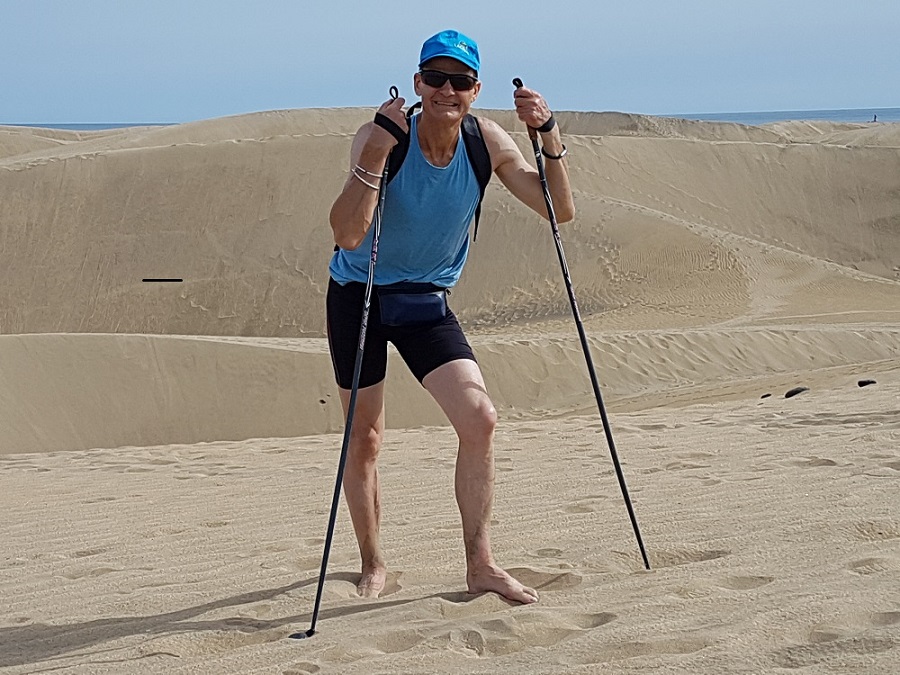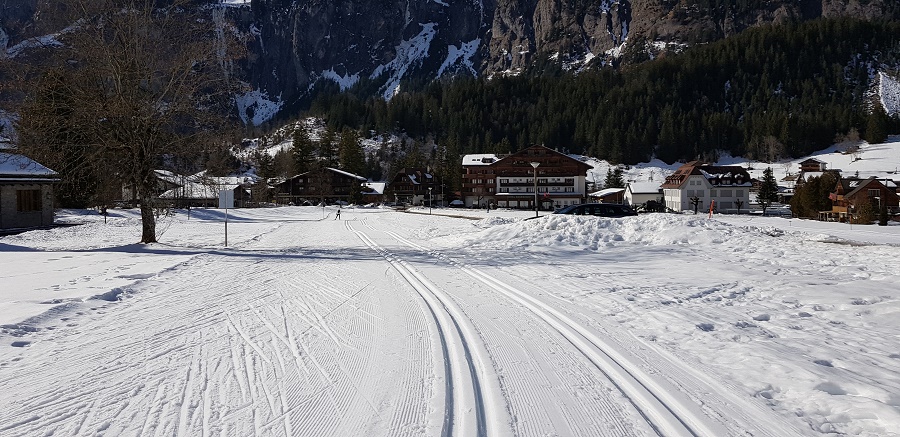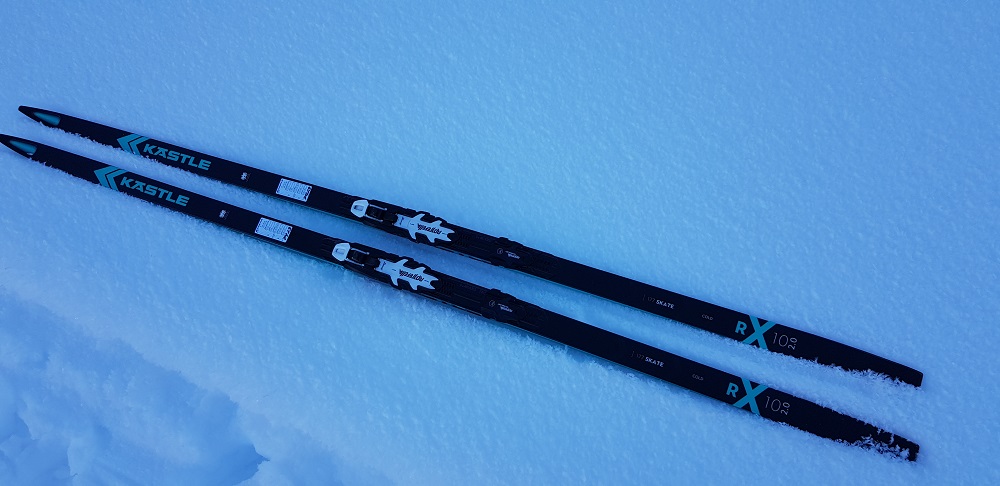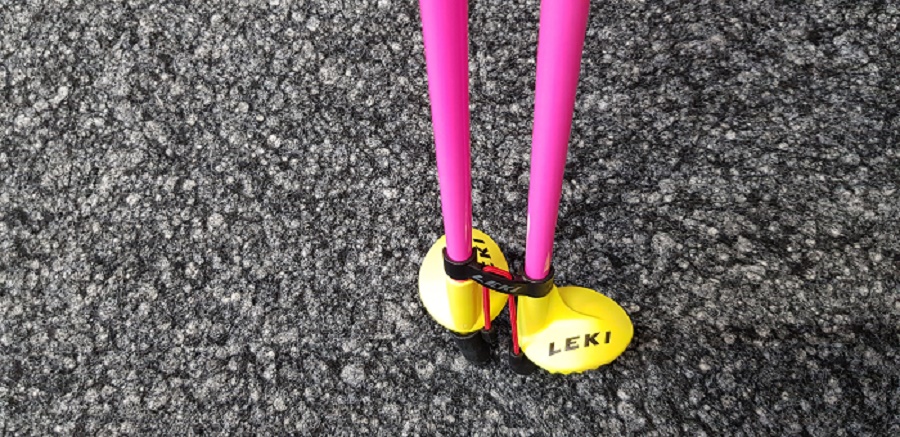Low intensity endurance training
Why you improve more with plenty of low intensity endurance training by staying in the green zone
Lots of low intensity endurance training is the foundation for any endurance athlete. The principles guide training methods are the same for all endurance sports. And it doesn't matter if that is XC skiing, running, cycling, rowing, or triathlon etc.
The difference is only in technique and strength training. From all endurance sports, cross country skiing and swimming are the most technical. Cross country skiers also need good lower and upper body strength as well as good balance for leg stability.
 Walking and running with poles in the warm sand in Gran Canaria during the spring. It's a perfect way to build a base with low intensity endurance training.
Walking and running with poles in the warm sand in Gran Canaria during the spring. It's a perfect way to build a base with low intensity endurance training.The foundation is simply low intensity endurance training built through various daily activities.
For a runner that’s running, for a cyclist biking, and a rower does row in most of his training sessions. But for you as a XC skier, you would have a more diversified training menu, which makes it quite unique.
Depending on what your training program calls for, you change daily to a different sport. You cycle, run, roller ski, snow ski and do strength training all year around.
There are no short cuts when it comes to any kind of endurance sports.
It’s as simple as that!
The deciding factor for capacity is your ability to work with increasing intensity without a build-up of muscle lactic acid. And to delay that build-up of lactic acid requires you to have a good base through low intensity endurance training.
Your muscles produce lactic acid when the workload becomes too high. And when that occurs, the amount of available oxygen is too low, and the muscles have to go anaerobic. So that’s why a solid endurance base is an absolute rule for a high anaerobic threshold.
The anaerobic threshold, which is the percentage of maximum capacity varies depending to how hard your muscles must deliver to do the work.
For XC skiers, the anaerobic threshold will vary for free style and classic skiing. The anaerobic threshold for skate skiing it is lower than that of classic skiers. The reason is that skate skiing produces more lactic acid in the leg and hip muscles.
That means when you push the lactate curve to the right so that you can work harder without going anaerobic, you are better prepared for hard races.
So, to ensure the most beneficial training, it is crucial to test yourself in a lab. This will establish your anaerobic threshold and VO2max values.
A coach can then look at the results and create a training plan according to your abilities, and time.
How to Build a Solid Base
As a coach and competitor, I apply the 5-Zone Intensity Scale used by the Norwegian Olympic Federation. Note that the intensity zones below are from the website of “researchgate.net".
So, from the intensity scale above, you can see that most of your low intensity endurance training should be in zone 1. Most of elite cross country skiers training sessions are in zone 1 and sometimes in zone 2.
I found the idea of the two former Norwegian Olympic Champions “Björn Daehlie and Vegard Ulvang” common sense. They did most of their endurance training at 70 – 75%. And so did Marit Bjoergen, the world’s best cross-country skier ever.
They were running, roller skiing and snow skiing lots of kilometers (miles) or hours at very low intensity. This is still true today. Only a very small percentage of 5 – 8% was high intensity training.
But at 1000 hours/year of training, that is still 50 – 80 hours of high intensity. In high intensity intervals, they were between 93-98% of maximal heart rate.
So does this apply to you as a recreational endurance athlete?
How Long and How Often
Low intensity endurance training can sometimes be a bit monotonous. So being a cross country skier has its advantages because you can always change your training equipment.
You may do a cycling session for 2 hours on the weekend. The next day, you may do a 1-hour run and include a few sprints at the beginning after the warm-up or at the end of the workout.
Then during the week, you include 1 or 2 sessions of roller skiing for 1 hour to 1 hour 30 min. Of course, you mix in two high intensity interval sessions. You could one by running using the poles and one by roller skiing towards the end of the week.
Then you add to that 2-3 strength training sessions depending on your time. I have found that a 30-min warm-up that includes 5 sprints of 8-10 seconds and/or 5 x 15 jumps uphill is a good way before doing a strength training session.
In the fall, you add a longer 3-hour workout on the weekend. Only this time, you may want to mix it up for variety. You could start with cycling for one hour, then roller skiing and the last hour with an easy run with or without your ski poles.
You can change around the order, but make sure to do attention to your roller ski technique. When you are getting tired in the third hour of this workout, your technique may suffer a bit. So go slow because the idea is to go long and not fast.
The trick here is that you don’t spend too much time for changing your equipment. Let somebody help you get your gear ready and stow it away afterwards. This takes time, but it’s well worth the effort.
If you have questions or want to leave a comment, email me and I get back to you.


